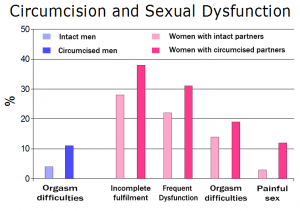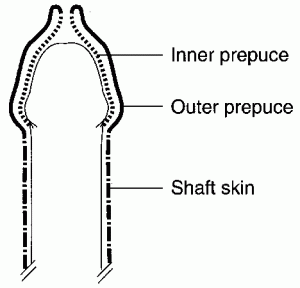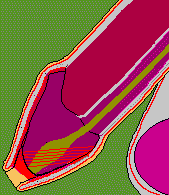Sexual Intercourse
 The pleasures derived from the foreskin have been known of for millenia. It’s only quite recently however, that definitive scientific research by Canadian doctor John Taylor has finally established what the anatomy of the foreskin is. His most significant finding is that of the ‘Ridged Band’, which was described in the ‘Anatomy and Function’ section. The variations from individual to individual means that not all penises can perform exactly the same. Due to the varying types of skin there’s likely to be differences in the elasticity and thickness of the penile skin. Also the length or shortness of the foreskin and the type of frenulum are likely to influence individual pleasure and enjoyment. From sex play and gaining experience through practice, individuals learn and find out what’s pleasurable and enjoyable for them.
The pleasures derived from the foreskin have been known of for millenia. It’s only quite recently however, that definitive scientific research by Canadian doctor John Taylor has finally established what the anatomy of the foreskin is. His most significant finding is that of the ‘Ridged Band’, which was described in the ‘Anatomy and Function’ section. The variations from individual to individual means that not all penises can perform exactly the same. Due to the varying types of skin there’s likely to be differences in the elasticity and thickness of the penile skin. Also the length or shortness of the foreskin and the type of frenulum are likely to influence individual pleasure and enjoyment. From sex play and gaining experience through practice, individuals learn and find out what’s pleasurable and enjoyable for them.
The movement of the foreskin is unique. As it becomes erect, the penile shaft becomes thicker and longer. The double-layered foreskin provides the skin necessary to accommodate the expanded organ and to allow the penile skin to glide freely, smoothly, and pleasurably over the shaft and glans. One of the foreskin’s functions is to facilitate a smooth and gentle movement between the mucosal surfaces of the two partners during intercourse and the foreskin’s “gliding action” which is the hallmark mechanical feature of the intact penis provides a non-abrasively smooth motion of the penis inside its own sheath of self-lubricating, movable skin between the mucosal surfaces of the vagina or anus facilitating smooth, comfortable, pleasurable intercourse for both partners…thus the ‘roll’ of the foreskin is its main salient feature in sexual intercourse.

During sexual intercourse…on the ‘out’ stroke, the foreskin re-covers the glans…and on the ‘in’ stroke it’s retracted to expose the glans by the forward motion…this ongoing ‘rolling’ motion is the hallmark of an intact penis
The foreskin enables the penis to slip in and out of the vagina, anus or mouth non-abrasively inside its own slick sheath of self-lubricating, movable skin. The partner is thus stimulated by moving pressure rather than by friction only, as when the male’s foreskin is missing, as the shaft of the circumcised penis functions as a leaky piston, drawing vaginal lubricants out into the drying air and often requiring other lubricants such as spit or artificial lubes essential for comfortable intercourse. The sexual experience is enhanced when the foreskin slips back on the in-stroke to allow the male’s ‘internal’ organ, the glans, to meet the female’s internal organ, the cervix (or prostate in the case of homosexual anal intercourse). On the in-stroke of intercourse, considered from the point of view of its stationary outer layer, the inner layer rolls outward and applies itself to the vagina / rectum. The ridged band engages with the internal ridges of the vagina / rectum. On the out-stroke, that movement reverses. Depending on the various dimensions and techniques used, there is considerable variation from that basic pattern and the two sets of ridges may then rub over each other like clothes on an old-fashioned washboard. That might be uncomfortable for women if the foreskin were dry like the circumcised penis. Instead, the effect is pleasurable. The foreskin fosters intimacy between the two partners by enveloping the glans and maintaining it as an internal organ.
Thus a circumcised penis without a foreskin will need more friction and stimulation to achieve orgasm and the female or male partner will be penetrated more forcefully either harder or faster or both. It is in the interests of the men and women who are penetrated orally, vaginally and anally to be aware that a circumcised penis will require more stimulation through increased vigorous pounding and pummelling for sensations, whereas an intact penis will generally glide and slide seamlessly with the foreskin retreating in on itself on the outward motion and retracting to expose the glans on the inward motion. A less forceful thrusting is more likely not to make sex an ordeal than it can otherwise be for some people. If a relatively tight foreskin is retracted, its tendency will be to remain retracted and its likely that intercourse will be with a retracted foreskin, which is the appropriate function of that particular foreskin.
In a 2011 Danish survey-based, cross-sectional study on ‘Male circumcision and sexual function in men and women’, the following conclusions were obtained: “Our study shows hitherto unrecognized associations between male circumcision and sexual difficulties in both men and women. While confirmatory findings in other settings are warranted, notably from areas where neonatal circumcision is more common, our findings may inform doctors and parents of baby boys for whom the decision of whether or not to circumcise is not dictated by religious or cultural traditions. Additionally, since it appears from our study that both men and women may have fewer sexual problems when the man is uncircumcised, and because preputial plasties may sometimes serve as suitable alternatives to standard circumcision, our study may stimulate a more conservative, tissue-preserving attitude in situations where foreskin pathology requires surgical intervention.”




